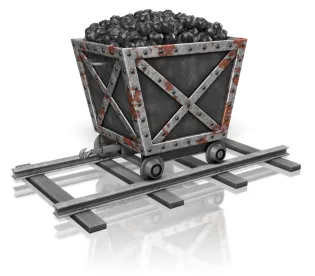The United States has ample coal deposits, but mining companies and their investors must contend with a growing number of environmental regulations that might affect the value of those deposits.
Heavy Regulation of Coal-Fired Power Plants Is Here to Stay
Coal-fired power plants in the United States are subject to extensive environmental regulations. Those regulations are likely to grow more stringent in the near future, possibly resulting in decreased domestic demand for coal. There are many examples of these regulations; the following are just a selection:
- In April 2014, the Supreme Court of the United States upheld the US Environmental Protection Agency’s (EPA’s) Cross-State Air Pollution Rule. This rule will likely require additional air emission controls to be installed on several midwestern power plants.
- In June 2014, EPA proposed new regulations that would limit greenhouse gas emissions from new and existing coal-fired electricity generating units.
- EPA is actively considering creating new, more stringent requirements for the handling of power plant coal ash.
- EPA is also developing new limitations on water discharges from coal-fired power plants, with a final rule expected on that topic by the end of 2015.
Many of the agency’s efforts are controversial and face strong legal and political opposition, but the agency remains under intense pressure to do even more to limit emissions from coal-fired power plants. This pressure comes not only from environmentalists, but also, with respect to air emissions, from several downwind states that receive a significant portion of their air pollution from upwind power plants. Investors should therefore continue to expect heavy regulatory activity in this arena.
EPA’s power plant regulations may serve to dampen domestic demand for coal and increase interest in UnitedStates to other countries. Export projects face various hurdles, however, sometimes even after they appear to have been finalised.
An ongoing lawsuit against the Export- Import Bank of the United States illustrates this point. In Chesapeake Climate Action Network, et al. v Export-Import Bank of the United States, et al., No. 1:13cv01820 (D.D.C.), a coalition of environmental groups contends that the bank violated the National Environmental Policy Act by guaranteeing a loan to Xcoal Energy & Resources LLC for use in connection with a coal export project, without first conducting a proper environmental review of the project’s impacts. If successful, the lawsuit could result in a revocation of the loan guarantee. Cases such as this mean entities pursuing coal export projects should anticipate both strong opposition and potential delays in obtaining necessary government approvals.
Methane Capture Regulations: Threat and Opportunity
Methane is a potent greenhouse gas (GHG). It is also the primary component of natural gas and can sometimes be sold as a product, rather than merely treated as a waste. In 2010, coal mining activity accounted for roughly 10 per cent of human-related methane emissions.
To date, EPA has declined to regulate coal mine methane emissions under the federal Clean Air Act. In May 2014, a federal appellate court agreed with EPA that the agency is not required to promulgate such regulations at the moment. The court held, in essence, that EPA could prioritise other regulations, such as GHG emission limits for power plants, over the coal mine regulations sought by the plaintiff environmental organisation.
This decision is a significant victory for the coal mining industry, but it does not necessarily mean that methane emission limits will not be imposed in the future, perhaps three or four years from now, after EPA finishes its power plant rules.
In the interim, a different federal agency, the US Bureau of Land Management (BLM), is considering imposing regulations of its own that would apply to methane emissions from underground coal mines on federal lands. In April 2014, BLM solicited comments on options for capturing such methane for sale, use or destruction. New BLM regulations, if promulgated, could raise costs for mining companies but might also provide opportunities for those companies to develop and sell a new product.
Mine Permits and the Federal Clean Water Act
An ongoing source of frustration for some mining companies has been EPA’s use of the federal Clean Water Act (CWA) to effectively veto the use of certain areas for the disposal of fill material and dredged material. In 2013, a federal appellate court held that EPA had the authority under Section 404 of the CWA to preclude the use of certain areas for disposal, even when the agency had previously acquiesced in CWA permits for those areas. In March 2014, the Supreme Court announced that it would not review that decision. This result is a significant loss for the mining industry, but mining companies do retain the right to challenge individual instances of EPA using its veto power, on a case-by-case basis.
Another topic of perennial controversy is the question of exactly when CWA permits are required. The controversy stems in part from confusion about which waterways are within the scope of the CWA’s applicability. In April 2014, EPA and the US Army Corps of Engineers released a proposed rule intended to clarify the meaning of the CWA’s phrase “waters of the United States”, and thereby to clarify the specific categories of waters that are subject to CWA jurisdiction and for which a permit is required before a business can discharge into them. Comments on the proposed rule are due by 20 October 2014. The agencies are expected to issue a final rule, after reviewing and addressing the comments, in April 2015.
Changing Climate Conditions and Extreme Weather
Changing climate patterns may create additional challenges for US mining operations. One set of challenges involves the changing climate itself; more rainfall in some areas might lead to more frequent flooding. Conversely, less rainfall in other areas might make mining more costly if access to the water needed for mining operations becomes more limited.
A second set of challenges involves the possibility of new regulations designed to ensure climate “resiliency”. President Obama has made resiliency to extreme weather events a central element of his Climate Action Plan, and increasing federal attention to that issue could lead to new regulatory proposals designed to strengthen mines against such events.
Opportunities to “RE-Power” Old Mines
If there is a silver lining for mine owners, it is that EPA is actively seeking ways to encourage the use of old mines as locations for renewable energy projects. Through its RE-Powering America’s Land initiative, the agency has created a set of resources, including mapping tools, to encourage the installation of solar, wind and other renewable energy projects on contaminated properties, including old mines. EPA’s interest in promoting such installations might create new revenue opportunities for the owners of some older, contaminated mine sites.




 />i
/>i
